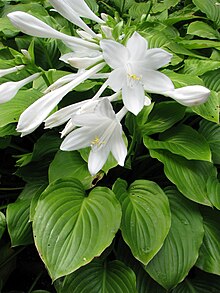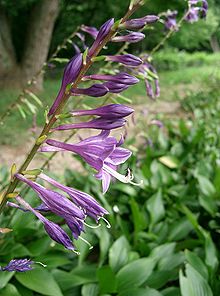Hostas
| Hostas | ||||||||||||
|---|---|---|---|---|---|---|---|---|---|---|---|---|

Hosta cultivar 'Bressingham Blue' |
||||||||||||
| Systematics | ||||||||||||
|
||||||||||||
| Scientific name | ||||||||||||
| Hosta | ||||||||||||
| Tratt. |
The funkias ( Hosta Tratt. , Syn .: Funkia Spreng. ), Also called heart leaf lilies , are a genus of plants from the subfamily of agave plants (Agavoideae) within the asparagus family (Asparagaceae). Most of the species originally come from Japan and the neighboring Asian region, with a few species each from China , Korea and Russia .
The genus is named after the German botanist and pharmacist Heinrich Christian Funck (1771-1839) or after the Austrian botanist and personal physician Nicolaus Thomas Host (1761-1834).
description
Hosta species grow as perennial, herbaceous plants . They form horizontal, large, short, often branched rhizomes ; sometimes they form runners . They produce many basal, spirally arranged leaves with long petioles. It can happen that new Hosta varieties form that have different leaf colors, so-called sports .
The stem of the inflorescence is usually covered with a few sessile, bract-like leaves. The terminal, racemose inflorescence contains few to many flowers and green to white bracts . The hermaphrodite, threefold flowers have a short flower stalk. The six white to blue or purple bracts are fused tubular to bell-shaped. The six stamens are mostly free, rarely fused with the base of the bracts. There are fruit capsules made with many black winged seeds.


species
There are around 22 types of hosta :
- Hosta albofarinosa D.Q. Wang : This species is endemic toChinaon grassy slopes at altitudes of around 800 meters in the southeastern area of Anhui Province.
- Hosta capitata (Koidz.) Nakai (Syn .: Hosta nakaiana F. Maek. ), Native to: southern Japan, southern Korea.
- Hosta clausa Nakai : It occurs from Russia's Far East to Korea.
- Dainty white-bordered hosta ( Hosta decorata L.H. Bailey ). It is also seen by some authors as a synonym for Hosta Sieboldiana .
- Hosta ensata F. Maek. : The species is native to Korea, Russia and China at altitudes from 0 to 500 meters (only in the southern areas of the two provinces of Jilin and Liaoning ). It is also seen as a synonym for Hosta clausa .
- Hosta hypoleuca Murata , native to: Japan (central Honshu).
- Hosta jonesii M.G.Chung : It occurs in southern Korea.
-
Hosta kikutii F. Maek. : With five varieties:
- Hosta kikutii var. Densinervia N.Fujita & MNTamura : It occurs in southern Honshu and Shikoku.
- Hosta kikutii var. Kikutii : It occurs in Kyushu.
- Hosta kikutii var. Polyneuron (F.Maek.) N.Fujita : It occurs in southern Shikoku.
- Hosta kikutii var. Scabrinervia N.Fujita & MNTamura : It occurs in central Shikoku.
- Hosta kikutii var. Tosana (F.Maek.) F.Maek. (Syn .: Hosta kikutii var. Caput-avis (F. Maek.) F.Maek. ): It occurs in southwestern Honshu and in southeastern Shikoku.
- Hosta kiyosumiensis F. Maek. (Syn .: Hosta pachyscapa F. Maek. ): Origin : Japan (Honshu).
- Lance-leaf Funkie ( Hosta lancifolia (Thunb.) Engl. , Syn .: Hosta cathayana F. Maek. ), Origin: Japan and Russia's Far East.
-
Autumn Funkia ( Hosta longipes (Franch. & Sav.) Matsum. , Syn .: Hosta tortifrons F. Maek. , Hosta tardiflora (W. Irving) Stearn ), home: Japan, Korea. With five varieties:
- Hosta longipes var. Aequinoctiiantha (Koidz. Ex Araki) Kitam. (Syn .: Hosta aequinoctiiantha Koidz. & Araki ): It occurs in central and west-central Honshu.
- Hosta longipes var. Caduca N.Fujita : Sioe comes in Korea, in the eastern Kyushu and western Shikoku.
- Hosta longipes var. Gracillima (F.Maek.) N.Fujita (Syn .: Hosta gracillima F. Maek. ): It occurs on Shikoku.
- Hosta longipes var. Latifolia F. Maek. (Syn .: Hosta rupifraga Nakai ): It occurs on the Izu Peninsula and on the Izu Islands .
- Hosta longipes var. Longipes : It occurs on Honshu.
- Hosta longissima F. Maek. , Home: Korea and western Honshu, Shikoku and Kyushu.
- Hosta minor (Baker) Nakai , native to Korea.
- Hosta nigrescens (Makino) F. Maek. : It is in culture in Japan.
- Lily Funkia ( Hosta plantaginea (Lam.) Asch. ) - a Chinese endemic, native to forests, rocky areas and on grassy slopes at altitudes between 0 and 2200 meters in the provinces of Anhui, Fujian , Guangdong , Guangxi , Hubei , Hunan , Jiangsu and Sichuan occurs.
- Hosta pulchella N. Fujita , origin: western Kyushu.
- Hosta pycnophylla F. Maek. , Homeland: western Honshu.
- Hosta shikokiana N. Fujita : Home is the central Shikoku.
-
Blue-leaf Funkie ( Hosta Sieboldiana (Hook.) Engl. ), Origin: Japan. With the varieties:
- Hosta Sieboldiana var. Glabra N. Fujita : It occurs on Honshu and the Oki Islands .
- Mountain Hosta ( Hosta sieboldiana var. Sieboldiana , Syn .: Hosta fluctuans F. Maek. , Hosta fortunei (Baker) LHBailey , Hosta kikutii var. Yakusimensis (Masam.) F.Maek. , H. sieboldiana var. Montana (F.Maek .) Zonn. , Hosta montana F. Maek. ): The home is Japan.
- White- bordered funkie or narrow- leaf funkie ( Hosta Sieboldii (Paxton) JW Ingram , Syn .: Hosta albomarginata (Hook.) Ohwi , Hosta ibukiensis Araki , Hosta rectifolia Nakai , Hosta rohdeifolia F. Maek. ): It comes from Sakhalin and the Kuriles to Japan.
- Hosta × tardiva Nakai = Hosta kikutii × Hosta Sieboldii . It occurs in Shikoku and Kyushu.
-
Hosta tsushimensis N. Fujita . With the varieties:
- Hosta tsushimensis var. Tibae (F.Maek.) N.Fujita & MNTamura (Syn .: Hosta tibae F. Maek. ): It occurs in Kyushu only in Nagasaki Prefecture.
- Hosta tsushimensis var. Tsushimensis : It occurs in Kyushu.
- Snow feather funkie ( Hosta undulata (Otto & A. Dietr.) LH Bailey ) - a frequently cultivated species with many varieties.
- Bell Funkia ( Hosta ventricosa Stearn ) - a Chinese endemic to forests, grassy slopes and mountain slopes at altitudes between 500 and 2,400 meters in the provinces of Anhui, Fujian, Guangdong, Guangxi, Guizhou , Hubei, Hunan, Jiangsu, Jiangxi and Sichuan. It is planted as an ornamental plant with several varieties in large areas of the world.
- Hosta venusta F. Maek. , Home: Jeju-do Islandof Korea.
- Hosta yingeri S.B. Jones (Syn .: Hosta jonesii M.G. Chung ): The home is southern Korea.
Use as an ornamental plant
Hostas are used in particular as ornamental leaf perennials and are considered to be important elements of shady or partially shaded garden areas on fresh soil, but can also be planted in pots. All species and varieties are hardy perennials that also thrive in Central Europe, they are undemanding and robust. This contributed to the fact that the Funkie was voted Perennial of the Year 2009 by the Association of German Perennial Gardeners
The leaves are multi-colored (yellow, blue, green) and patterned (e.g. variegated ). The originally great importance of the species declined towards the end of the 20th century due to the increasing number of varieties.
Multiplication
Pure species are usually propagated by the frost-hardy seeds, whereas varieties tend to be vegetative, mostly by division. However, professional nurseries in the USA, Great Britain, the Netherlands and Germany are increasingly turning to tissue culture .
Pests and diseases
Hostas are often eaten by slugs.
Hostas can be infected by various viruses. Hosta Virus X (HVX), discovered in 1996, plays a particularly important role.
photos
swell
- Chen Xinqi, David E. Boufford: Hosta. In: Wu Zheng-yi, Peter H. Raven (Ed.): Flora of China . Volume 24: Flagellariaceae through Marantaceae . Science Press / Missouri Botanical Garden Press, Beijing / St. Louis 2000, ISBN 0-915279-83-5 , pp. 204 (English). , online .
- Frederick H. Utech: Hosta. In: Flora of North America Editorial Committee (Ed.): Flora of North America North of Mexico . Volume 26: Magnoliophyta: Liliidae: Liliales and Orchidales . Oxford University Press, New York / Oxford a. a. 2002, ISBN 0-19-515208-5 , pp. 222 (English). , online .
- Walter Erhardt , Erich Götz, Nils Bödeker, Siegmund Seybold: The great pikeperch. Encyclopedia of Plant Names. Volume 2: Types and Varieties. Eugen Ulmer, Stuttgart 2008, ISBN 978-3-8001-5406-7 .
- Fritz Köhlein: Hosta (hostas). Ulmer Verlag, Stuttgart 1993, ISBN 3-8001-6513-9 .
Individual evidence
- ↑ Funkie Wissenschaft-online.de
- ↑ a b c d e f g h i j k l m n o p q r s t u v w x y z aa ab ac ad ae af ag ah ai aj Rafaël Govaerts (ed.): Hosta. In: World Checklist of Selected Plant Families (WCSP) - The Board of Trustees of the Royal Botanic Gardens, Kew . Retrieved July 30, 2018.
- ↑ Declaration by BdS 2009, Online ( Memento of the original dated February 4, 2010 in the Internet Archive ) Info: The archive link was automatically inserted and not yet checked. Please check the original and archive link according to the instructions and then remove this notice.
- ↑ a b c Hans Simon (Ed.): The free-range ornamental shrubs. Manual and lexicon of garden perennials . Founded by Leo Jelitto, Wilhelm Schacht. 5th completely revised edition. tape 1 : A-H . Eugen Ulmer, Stuttgart (Hohenheim) 2002, ISBN 3-8001-3265-6 , pp. 471-472 .
- ↑ Article about the Hosta Virus X ( Memento of the original from August 11, 2015 in the Internet Archive ) Info: The archive link was inserted automatically and has not yet been checked. Please check the original and archive link according to the instructions and then remove this notice.








